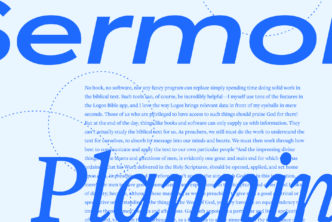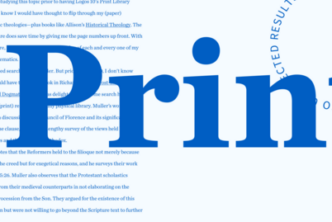The Theology Guide in Logos will do something most people consider it impossible to do: it will change theologians’ minds.
Theologians have long known that Logos is a good tool for the study of Scripture, but to some of them that’s all it was. Now, theologians, Logos can guide your studies, too.
Search for “Image of God,” for example, in the Theology Guide, and you’ll get quick access to all the major tools of the Lexham Survey of Theology—and there’s a lot of them.
Let me explain how they work.
Think of the Lexham Survey of Theology (LST) as three things:
1. The LST is a mind map
The LST is a “mind map” of all the major topics in systematic theology. It organizes them in a visual hierarchy that captures their interrelationships.
I’ve been working on this project for many months, and during that time I’ve found that the map has been repeatedly helpful. I’ve got a copy hanging in my office, and I consult it not only for the project but for other writing and Bible teaching I do.
For example, I’m writing up a little discipleship book on bibliology for a church. When I began the work, I looked at the mind map for “The Doctrine of Scripture and Revelation” and I got a quick overview. The mind map oriented me to the “branches” of the doctrine, and—I noticed this especially—it helped me make sure to cover all the bases.
I’m writing for new Christians, and it was helpful for me to be reminded of something simple, that the Bible mentions “Unwritten Special Revelation” such as “Theophanies” and “Dreams.” People who have no idea what Christianity teaches need to distinguish Scripture, written special revelation, from these other sources. New believers coming out of different religions need to know the special place Scripture holds in the Christian faith. The LST mind map reminded me to cover ( briefly) those other topics. (I happened to write the LST article on Theophanies—I probably should have remembered it.)
2. The LST is a set of written introductions to all the major topics of Christian theology
The LST provides a brief (300–1000-word) introduction to each of its 234 theological topics, written by a multi-denominational group of Protestant theologians. Contributors were asked to be objective, sympathetic, reverent, and scholarly. Each introduction includes a brief definition and an article-length description of the orthodox (small-“o”) approach to that doctrine.
We asked scholars such as Fred Sanders, Gerald Bray, John Frame, and Fred Zaspel to write these pieces for us. And they came through. Sanders produced eight, one for each major locus of theology. Bray did a full 25—one for each subpoint below the top level. Frame did 15, all of them in bibliology.
One thing I particularly enjoyed as I edited these pieces was the impulse so many writers felt to end on a homiletical note. I like theological writers who care about the church and relate the Bible’s teachings to human needs. One example was Jonathan Warren, whose prose was a delight to this editor, and who found the perfect quotation to finish out his article on Jesus’ impeccability (the doctrine that Jesus could not sin).
The Presbyterian W. G. T. Shedd (1820–1894) develops this patristic line of thought to distinguish between temptability, which depends upon “constitutional susceptibility” to sin, and impeccability, which depends upon the absolute indefectibility of Christ’s human willing. To say that his temptability requires his peccability is not true “any more than it would be correct to say that because an army cannot be conquered, it cannot be attacked.”
I found that precious—worth remembering and repeating. And I ran into many insights like these while editing submissions.
We asked writers to orient readers to the historical and contemporary conversations on their assigned doctrine. Particularly (but not only) in controversial areas of theology, we instructed them to lean toward the objective and descriptive—though no one was asked to pretend that he or she had no viewpoint.
We also asked contributors to hand-pick a a list of key Bible passages, a list of recommended resources, and links to related concepts within the Lexham Survey of Theology.
To sum up: each LST article includes, in order:
- A definition: A brief summary of the doctrine at hand
- A description: An article-length description of the orthodox (again, small-“o”) approach to that doctrine follows the definition.
- Key passages: A list of key Bible passages chosen by the contributors
- Recommended resources: A list of resources recommended by the contributors
- Related concepts: Links to related concepts, chosen by the contributor
3. The LST is an index to your systematic theologies
I’m not the kind of writer who says, “This is huge” very often.
This is huge.
The LST links directly to a growing list of systematic theologies in Logos Bible Software. It functions as an index to what numerous theologians say about any given theological topic: Jesus as Mediator, The Kingdom of God, Life After Death, General Revelation, Providence and Miracles, Covenants, Unity in the Trinity, Plurality in the Trinity, Original Sin—and 225 more.
If you are studying Union with Christ, you can look it up in index after index or let the LST do it for you.
The Lexham Survey of Theology does for systematic theologies what the Bible reference system (“3:16”; “40:1”) has done for commentaries, journals, and other biblical studies resources. (Did I say “huge”?)
The Theology Guide
The Lexham Survey of Theology is the ideal tool for entering study of a given doctrine of the Christian faith. It’s where I personally will start from now on.





